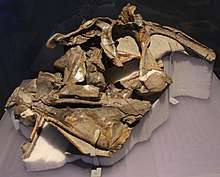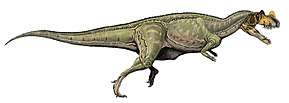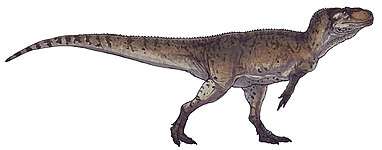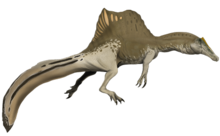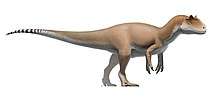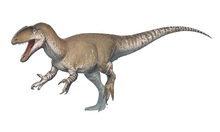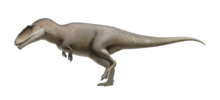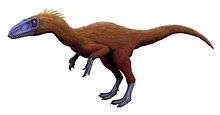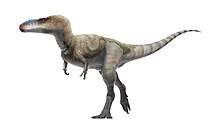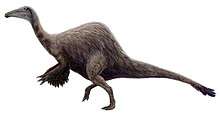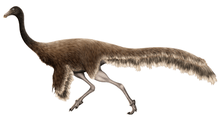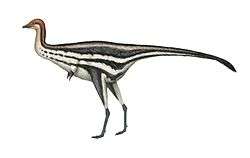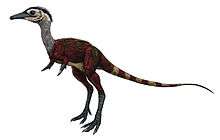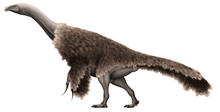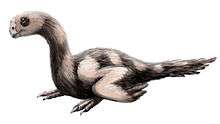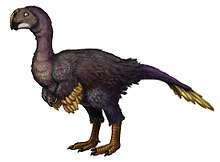Cryolophosaurus
Cryolophosaurus (/ˌkraɪoʊˌloʊfoʊˈsɔːrəs/ or /kraɪˌɒloʊfoʊˈsɔːrəs/; "CRY-oh-loaf-oh-SAWR-us") is a genus of large theropods known from only a single species Cryolophosaurus ellioti, known from the early Jurassic period of Antarctica. It was about 6.5 metres (21.3 ft) long and 465 kilograms (1,025 lb) in weight, making it one of the largest theropods of its time. Individuals of this species may have grown even larger, because the only known specimen probably represents a sub-adult. Cryolophosaurus is known from a skull, a femur and other material, the skull and femur of which have caused its classification to vary greatly. The femur possesses many primitive characteristics that have classified Cryolophosaurus as a dilophosaurid or a neotheropod outside of Dilophosauridae and Averostra, whereas the skull has many advanced features, leading the genus to be considered a tetanuran, an abelisaurid, a ceratosaur and even an allosaurid. Since its original description, the consensus is that Cryolophosaurus is either a primitive member of the Tetanurae or a close relative of that group.
| Cryolophosaurus | |
|---|---|
 | |
| Reconstructed skeleton, Field Museum of Natural History | |
| Scientific classification | |
| Kingdom: | Animalia |
| Phylum: | Chordata |
| Clade: | Dinosauria |
| Clade: | Saurischia |
| Clade: | Theropoda |
| Clade: | Neotheropoda |
| Clade: | Averostra |
| Clade: | Tetanurae |
| Genus: | †Cryolophosaurus Hammer & Hickerson, 1994 |
| Type species | |
| †Cryolophosaurus ellioti Hammer & Hickerson, 1994 | |
Cryolophosaurus possessed a distinctive "pompadour" crest that spanned the head from side to side. Based on evidence from related species and studies of bone texture, it is thought that this bizarre crest was used for intra-species recognition. The brain of Cryolophosaurus was also more primitive than those of other theropods.
Cryolophosaurus was first excavated from Antarctica's Early Jurassic, Sinemurian to Pliensbachian aged Hanson Formation, formerly the upper Falla Formation, by paleontologist Dr. William Hammer in 1991. It was the first carnivorous dinosaur to be discovered in Antarctica and the first non-avian dinosaur from the continent to be officially named. The sediments in which its fossils were found have been dated at ~194 to 188 million years ago, representing the Early Jurassic Period.
Discovery and naming
Cryolophosaurus originally was collected during the 1990–91 austral summer on Mount Kirkpatrick in the Beardmore Glacier region of the Transantarctic Mountains. The discovery was made by Hammer, a professor at Augustana College, and his team. The fossils were found in the siliceous siltstone of the Hanson Formation, formerly the upper Falla Formation, and dated to the Pliensbachian Stage of the early Jurassic. Cryolophosaurus was the second dinosaur, and first theropod, to be discovered in Antarctica. It was discovered after Antarctopelta, but named earlier.[1]
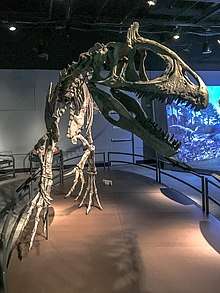
In 1991, both Hammer and the Ohio State University geologist David Elliot excavated separate outcrops near Beardmore Glacier, sharing logistical expenses. Elliot's team first came across the remains of Cryolophosaurus in a rock formation around the altitude of 4,000 m (13,000 ft) high and about 640 km (400 mi) from the South Pole. When the discovery was made, they soon notified Hammer. Over the next three weeks, Hammer excavated 2,300 kg (5,100 lb) of fossil-bearing rock. The team recovered over 100 fossil bones, including those of Cryolophosaurus.[1] The specimens were formally named and described in 1994 by Hammer and Hickerson, in the journal Science.[1]
During the 2003 season, a field team returned and collected more material from the original site. A second locality was discovered about 30 metres (98 ft) higher in the section on Mt. Kirkpatrick.[2]
The name Cryolophosaurus ellioti is derived from the Greek words κρυος (meaning 'cold' or 'frozen', in reference to its discovery in Antarctica), λοφος (meaning 'crest') and σαυρος (meaning 'lizard'), thus "cold crest lizard". Hammer and Hickerson named the species C. ellioti, after David Elliot, who had made the initial discovery of the fossils.[1]
Description
.jpg)
The holotype FMNH PR1821 is the only fully described specimen of Cryolophosaurus. The specimen consists of an incomplete skull and mandibles lacking most of their front half; nine maxillary teeth; a fragmentary sixth cervical centrum; cervical vertebrae 7-10; several posterior cervical ribs; several anterior dorsal vertebrae; most mid and posterior dorsal vertebrae; several dorsal ribs; the fifth sacral vertebrae; three chevrons; many partial and complete caudal vertebrae and centra; two partial humeri; a proximal radius; a proximal ulna; a partial ilium; a proximal pubis; both ischia, but only one distal; two incomplete femora; the distal end of a tibia; the distal end of a fibula, and the astragalus and calcaneum.[3] In 2013, new material of Cryolophosaurus was unearthed in Antarctica. The description of this material has not yet been published in a non-abstract form.[4]

Cryolophosaurus was a large, well-built theropod, one of the largest of its time. The genus has been described by Roger Benson and colleagues (2012) as a top predator in Antarctica. It had slender proportions.[5] Cryolophosaurus was estimated as being 6 to 7 m (19.7 to 23.0 ft) in length by William R. Hammer & William J. Hickerson (1999).[6] A 2007 study by Nathan Smith et al. revised the length to 6.5 m (21.3 ft).[3] Its weight estimated at 465 kilograms (1,025 lb).[3] Based on these length and weight estimates, Cryolophosaurus is currently the largest known Early Jurassic theropod.[5][7] Smith et al. (2007b) and Benson et al. (2012) noted that the holotype individual probably represents a sub-adult, so adults could have been larger.[3][5] In 2016 Molina-Pérez and Larramendi gave a larger estimation of 7.7 meters (25.3 ft) and 780 kg (1.720 lbs).[8]
Skull

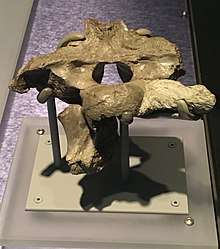
The holotype of Cryolophosaurus consists of a high, narrow skull, which was discovered articulated with the rest of the skeleton.[6] The skull is an estimated 65 centimetres (26 in) long. It has a peculiar nasal crest that runs just over the eyes, where it rises up perpendicular to the skull and fans out. It is thin and highly furrowed, giving it a unique "pompadour" appearance and earned it the nickname "Elvisaurus."[9] The crest is an extension of the skull bones, near the tear ducts, fused on either side to orbital horns which rise from the eye sockets. While other theropods like the Monolophosaurus have crests, they usually run along the skull instead of across it.[10]
An unpublished study conducted by Vernon Meidlinger-Chin in 2013 suggested that previous studies lacked focus on endocranial details. The study found that the Cryolophosaurus fossil has a nearly complete, undistorted cranial cavity which is complete enough to give an approximate shape and size of the living brain. The endocast features clarified the dissimilarity of the skull with those of Allosauroids and Coelurosaurs giving Cryolophosaurus a basal position in Theropoda.[7] Closer examination of how the skull bones fused together reviewed details in the snout and forehead that are especially similar to Dilophosaurus.[11]
Classification
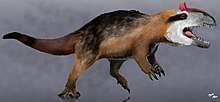
Classification of Cryolophosaurus is difficult because it has a mix of primitive and advanced characteristics. The femur has traits of early theropods, while the skull resembles much later species of the clade Tetanurae, like China's Sinraptor and Yangchuanosaurus. This led Paul Sereno et al. (1994) to place Cryolophosaurus in the taxon Allosauridae.[12] Originally, Hammer and colleagues suspected that Cryolophosaurus might be a ceratosaur or even an early abelisaur, with some traits convergent with those of more advanced tetanurans, but ultimately concluded that it was itself the earliest known member of the tetanuran group.[1] While a subsequent study by Hammer (along with Smith and Currie) again recovered Cryolophosaurus as a tetanuran, a later (2007) study by the same authors found that it was more closely related to Dilophosaurus and Dracovenator.[10][13] Sterling Nesbitt et al. (2009), using the characters of Tawa found Cryolophosaurus to be a neither dilophosaurid nor averostran neotheropod but instead the sister group of a clade composed of dilophosaurids and averostrans.[14] However, in 2012, Matthew Carrano found that Cryolophosaurus was a tetanuran, related to Sinosaurus, but unrelated to Dilophosaurus.[15]

The following family tree illustrates a synthesis of the relationships of the early theropod groups compiled by Hendrickx et al. in 2015.[16]
| Neotheropoda |
| |||||||||||||||||||||||||||||||||||||||||||||||||||||||||
Paleobiology
Cranial ornamentation

Cranial display features, such as the one possessed by Cryolophosaurus, make sense in social, gregarious animals, where other members of the species are available to observe and interpret messages of sexual status.[17] Kevin Padian et al. (2004) challenged conventional hypotheses that the purpose of bizarre cranial structures and post-cranial armor in dinosaurs, was either for attracting mates, intimidating/fighting rivals in the group, or intimidating potential predators of other species. Padian et al. noted that based on phylogenetic, histological, and functional evidence these bizarre structures can be explained by the phenomenon of intra-species recognition, which is supported by the fossil evidence.[18][19] Thomas R. Holtz Jr. (2010) found that the bizarre crest of Cryolophosaurus was primarily for intra-species recognition, based on evidence from related species and studies of bone texture.[20] According to Thomas Rich and his colleagues, the crest would have been ineffective as a weapon and may have possibly functioned as a display feature during certain types of social behavior such as mating.[21] In 2019, a species recognition function was disputed but a socio-sexual display structure model was suggested.[22]
Diet
When the type specimen was discovered, several long cervical ribs, of a supposed prosauropod dinosaur were found in the mouth of Cryolophosaurus, which led Hammer (1998) to conclude that it was feeding on the prosauropod when it died. Hammer further noted that since the ribs were found extending all the way back to the theropod's neck region, this individual may have choked to death on these ribs.[6] However, Smith et al. concluded that these remains belonged to the Cryolophosaurus specimen itself, and not to Hammer's "prosauropod".[13] Hammer also concluded that a post-canine tooth belonging to a tritylodont (an early mammal relative), found with the remains, was part of its stomach contents when it died.[23]
Paleopathology
Some Cryolophosaurus bones have pathologies that show evidence of scavenging. Broken teeth from a juvenile Cryolophosaurus were found nearby.[21] These teeth have no roots and likely shed naturally while scavenging the adult Cryolophosaurus carcass.
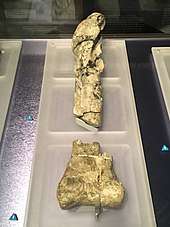
Another possible pathology is found in the astragalus (ankle bone) of Cryolophosaurus. This bone was preserved with a small splint from the fibula located just above the ankle. The splint, however, may also be just a unique morphological feature of Cryolophosaurus.[3]
Paleoecology

All known specimens of Cryolophosaurus have been recovered in the Hanson Formation, which is one of only two major dinosaur-bearing rock formations found on the continent of Antarctica. It was discovered in "tuffaceous" siltstone deposited in the Sinemurian to Pliensbachian stage of the Early Jurassic,[6] approximately 194 to 188 million years ago.[4][24] This geological formation is part of the Victoria Group of the Transantarctic Mountains, which is approximately 4,000 metres (13,000 ft) above sea level.[6] The high altitude of this site supports the idea that early Jurassic Antarctica had forests populated by a diverse range of species, at least along the coast.[25][26] The Hanson Formation was deposited in an active volcano−tectonic rift system formed during the breakup of Gondwana.[13]
In the Early Jurassic, Antarctica was closer to the equator and the world was considerably warmer than today, but the climate was still cool temperate.[27] Models of Jurassic air flow indicate that coastal areas probably never dropped much below freezing, although more extreme conditions existed inland.[28] Cryolophosaurus was found about 650 kilometres (400 mi) from the South Pole but,[6] at the time it lived, this was about 1,000 km (621 mi) or so farther north.[25] This formation has produced the remains of Glacialisaurus[29] (a large basal sauropodomorph), a crow-sized pterosaur (a dimorphodontid), a synapsid (a tritylodont, which is a type of synapsid about the size of a rat), herbivorous synapsid, and two small unnamed sauropodmorphs.[1] There are also the remains of many plant genera recovered from the Early Jurassic Camp Hill Formation, around the same age as fossils of Cryolophosaurus, proving that dense plant matter had once grown on Antarctica's surface before it drifted southward.[30]
References
- Hammer, W. R.; Hickerson, W. J. (1994). "A Crested Theropod Dinosaur from Antarctica". Science. 264 (5160): 828–830. Bibcode:1994Sci...264..828H. doi:10.1126/science.264.5160.828. PMID 17794724.
- Leslie, M (2007). "The Strange Lives of Polar Dinosaurs". Smithsonian Magazine. Archived from the original on 2012-07-02. Retrieved 2008-01-24.
- Smith, N.D.; Makovicky, P.J.; Hammer, W.R.; Currie, P.J. (2007). "Osteology of Cryolophosaurus ellioti (Dinosauria: Theropoda) from the Early Jurassic of Antarctica and implications for early theropod evolution" (PDF). Zoological Journal of the Linnean Society. 151 (2): 377–421. doi:10.1111/j.1096-3642.2007.00325.x.
- Smith, N.D.; Hammer, W.R.; Makovicky, P.J. (2013). "New Dinosaurs from the Early Jurassic Hanson Formation of Antarctica, and Patterns of Diversity and Biogeography in Early Jurassic Sauropodomorphs". Geological Society of America Abstracts with Programs: 405–406. Archived from the original on 2017-12-22. Retrieved 2013-12-20.
- Benson, R.; Brusatte, S.; Hone, D.; Naish, D.; Xu, X.; Anderson, J.; Clack, J.; Duffin, C.; Milner, A.; Parsons, K.; Prothero, D.; Johanson, Z.; Dennis-Bryan, K. (2012) [2009]. Ambrose, Jamie; Gilpin, David; Hirani, Salima; Jackson, Tom; Joyce, Nathan; Maiklem, Lara; Marriott, Emma; Nottage, Claire; van Zyl, Meizan (eds.). Prehistoric Life: A Definitive Visual History of Life on Earth. Dorling Kindersley. pp. 1–512. ISBN 978-0-7566-9910-9. OCLC 444710202.
- Hammer, W.R.; Hickerson, W.J. (1999). Tomida, Y.; Rich, T.H.; Vickers-Rich, Y. (eds.). "Gondwana Dinosaurs from the Jurassic of Antarctica". Proceedings of the Second Gondwana Dinosaur Symposium National Science Museum Monographs. 15: 211–217.
- Meidlinger-Chin, V. (2013). "Braincase and Endocranial anatomy of Cryolophosaurus ellioti (Dinosauria: Theropoda) from the Early Jurassic of Antarctica". Geological Society of America Abstracts with Programs. 45 (4): 65.
- Molina-Pérez & Larramendi (2016). Récords y curiosidades de los dinosaurios Terópodos y otros dinosauromorfos. Barcelona, Spain: Larousse. p. 254.
- swigodner (2017-08-02). "Antarctic Dinosaurs". Field Museum. Retrieved 2018-12-31.
- Smith, N. D.; Hammer, W.R.; Currie, P.J. (2005). "Osteology and phylogenetic relationships of Cryolophosaurus ellioti (Dinosauria: Theropoda): Implications for basal theropod evolution". Journal of Vertebrate Paleontology. 25 (3): 116A–117A. doi:10.1080/02724634.2005.10009942.
- "VERTEBRAL ANATOMY OF CRYOLOPHOSAURUS ELLIOTI, A THEROPOD DINOSAUR FROM THE EARLY JURASSIC OF ANTARCTICA". gsa.confex.com. Archived from the original on 2019-01-01. Retrieved 2018-12-31.
- Sereno, P.C.; Wilson, J.A.; Larsson, H.C.E.; Dutheil, D.B.; Sues, H-D. (1994). "Early Cretaceous dinosaurs from the Sahara". Science. 266 (5183): 267–270. Bibcode:1994Sci...266..267S. doi:10.1126/science.266.5183.267. PMID 17771449.
- Smith, N. D.; Makovicky, P.J.; Pol, D.; Hammer, W.R.; Currie, P.J. (2007). "The Dinosaurs of the Early Jurassic Hanson Formation of the Central Transantarctic Mountains: Phylogenetic Review and Synthesis". US Geological Survey Open-File Report. 2007 (1047srp003). doi:10.3133/of2007-1047.srp003.
- Nesbitt, S.J.; Smith, N.D.; Irmis, R.B.; Turner, A.H.; Downs, A.; Norell, M.A. (2009). "A complete skeleton of a Late Triassic saurischian and the early evolution of dinosaurs". Science. 326 (5959): 1530–1533. Bibcode:2009Sci...326.1530N. doi:10.1126/science.1180350. PMID 20007898.
- Carrano, M. T.; Benson, R. B. J.; Sampson, S. D. (2012). "The phylogeny of Tetanurae (Dinosauria: Theropoda)". Journal of Systematic Palaeontology. 10 (2): 211–300. doi:10.1080/14772019.2011.630927.
- Hendrickx, C.; Hartman, S.A.; Mateus, O. (2015). "An Overview of Non- Avian Theropod Discoveries and Classification". PalArch's Journal of Vertebrate Palaeontology. 12 (1): 1–73.
- Dodson, P. (1997). "Paleoecology". In Currie, P.J.; Padian, K. (eds.). Encyclopedia of Dinosaurs. Academic Press. ISBN 978-0-12-226810-6.
- Glut, D.F. (2006). Dinosaurs, the Encyclopedia, Supplement 4. McFarland & Company, Inc. p. 749. ISBN 978-0-7864-2295-1.
- Padian, K.; Horner, J.R.; Dhaliwal, J. (2004). "Species recognition as the principal cause of bizarre structures in dinosaurs". Journal of Vertebrate Paleontology. 23 (3 Suppl): 100A. doi:10.1080/02724634.2003.10010538.
- Holtz, T.R. Jr. (2012). Dinosaurs: The Most Complete, Up-to-Date Encyclopedia for Dinosaur Lovers of All Ages. Random House Books for Young Readers. pp. 90–91. ISBN 978-0-375-82419-7.
- Rich, T.R.; Gangloff, R.A.; Hammer, W.R. (1997). "Polar dinosaurs". In Currie, P.J.; Padian, K. (eds.). Encyclopedia of Dinosaurs. Academic Press. pp. 562–573. ISBN 978-0-12-226810-6.
- Chan-gyu, Yun. (2019). "An enigmatic theropod Cryolophosaurus: Reviews and Comments on its paleobiology". Volumina Jurassica. 17: 1–8.
- Glut, D.F. (1999). Dinosaurs, the Encyclopedia, Supplement 1. McFarland & Company, Inc. p. 442. ISBN 978-0-7864-0591-6.
- Evans, D.C.; Vavrek, M.J. (2012). Ultimate Dinosaurs: Giants from Gondwana. Toronto:Royal Ontario Museum. pp. 30–1.
- Dodson, P. (1997). "Distribution and Diversity". In Currie, P.J.; Padian, K. (eds.). Encyclopedia of Dinosaurs. Academic Press. pp. 10–13. ISBN 978-0-12-226810-6.
- Holtz, T.R. Jr.; Molnar, R.E.; Currie, P.J. (2004). "Basal Tetanurae". In Weishampel, D.B.; Dodson, P.; Osmólska, H. (eds.). The Dinosauria (Second ed.). University of California Press. pp. 71–110. ISBN 978-0-520-24209-8.
- Pickrell, John (2004). "Two New Dinosaurs Discovered in Antarctica". National Geographic. Retrieved 20 December 2013.
- Chandler, M. A.; Rind, D.; Ruedy, R. (1992). "Pangaean climate during the Early Jurassic: GCM simulations and the sedimentary record of paleoclimate". Geological Society of America Bulletin. 104 (5): 543. Bibcode:1992GSAB..104..543C. doi:10.1130/0016-7606(1992)104<0543:PCDTEJ>2.3.CO;2.
- Smith, Nathan D.; Pol, Diego (2007). "Anatomy of a basal sauropodomorph dinosaur from the Early Jurassic Hanson Formation of Antarctica" (PDF). Acta Palaeontologica Polonica. 52 (4): 657–674.
- Rees, P.M. & Cleal, C.J. (2004). "Lower Jurassic floras from Hope Bay and Botany Bay, Antarctica" (PDF). Special Papers in Palaeontology. 72: 5–90. Archived from the original (PDF) on 2010-07-22.CS1 maint: uses authors parameter (link)
External links
| Wikispecies has information related to Cryolophosaurus |
| Wikimedia Commons has media related to Cryolophosaurus. |
- Transantarctic Vertebrate Paleontology Project, official website for the NSF project conducting research on Cryolophosaurus and related fauna (photos, research information, publication list, geology, project members ...)
- Fryxell Geology Museum (photos, information)
- Field Museum of Natural History (video, information)
